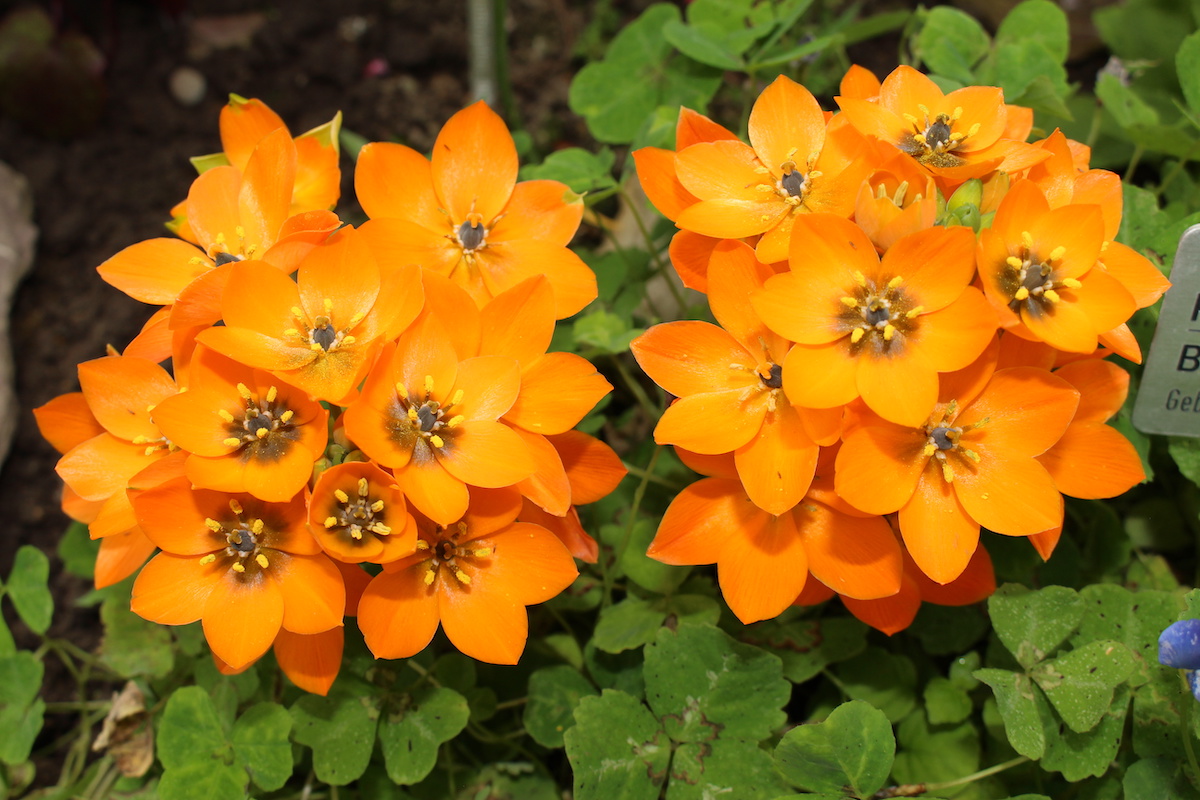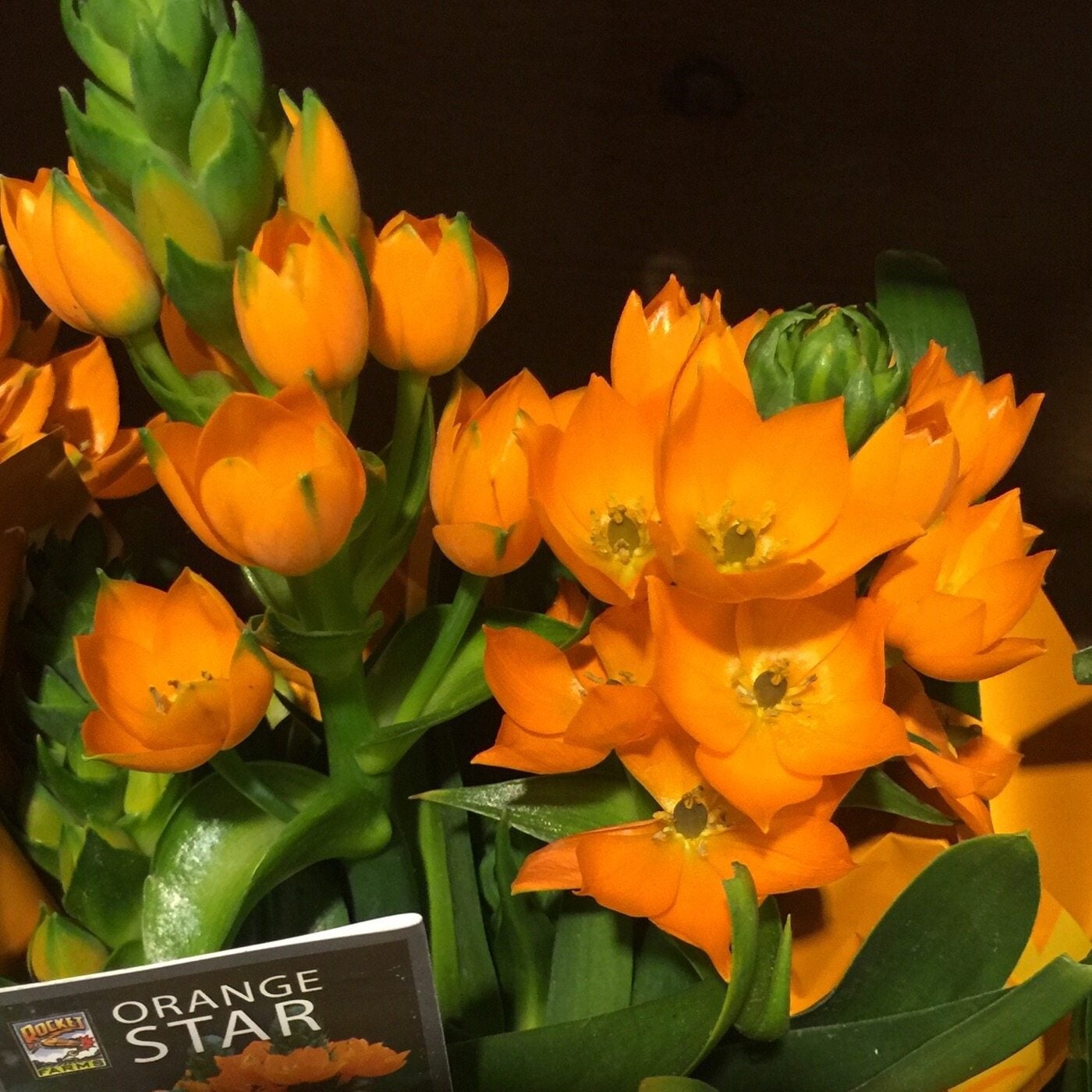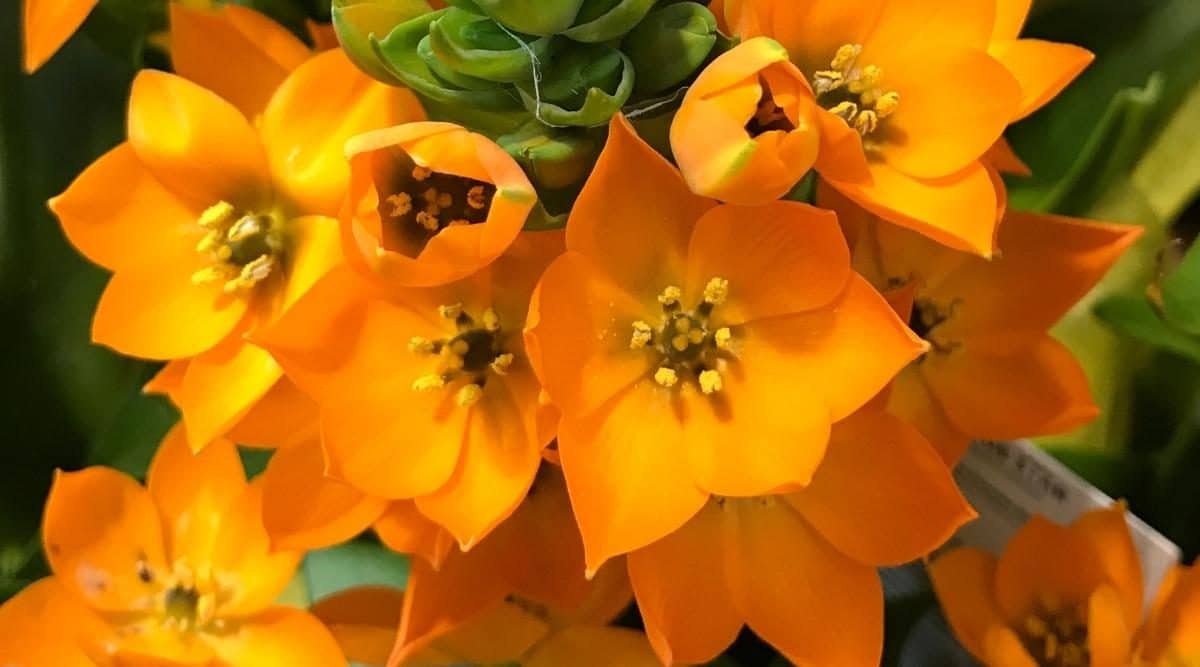
One of the lovely flowering plants with a star-like shape and a core of a brown or green color is the orange star plant (flower). Its moniker, Star of Bethlehem, is quite well known.
Additionally, they make lovely gifts because of how gorgeous they are. You can grow these in a pot or in your garden; they will give color to the scenery of your garden. You can also put them in the garden’s borders.
Let’s now quickly review its historical background.
This lovely floral plant is well-known by the popular names Star of Bethlehem and Sun Star. It originates from the South African continent’s Cape province. Ornithogalum dubium is the botanical name for this plant, which belongs to the Asparagaceae family. These plants are quite lovely and grow to a height of around 17 to 20 inches (45 to 50 cm). They grow in clusters of 6–25 yellowish or orange flowers with a form that resembles a bulb.
Tepals are the outermost component of a flower, and from what I can learn, they were not regarded as either petals or sepals. These tepals can develop in a variety of colors, including yellow, orange, red, and very infrequently, white with either a brown or green core.
Table of Contents
(Ornithogalum dubium) How to Grow Orange Star Plant
You must first have the plant’s seeds or bulbs in order to grow orange star flower. The plant produces these little seeds at the end of the summer, and they are simple to separate. This plant must be grown in well-draining soil (it was grown in rock garden often times)
Peat moss and sand together can make excellent potting soil. These plants need at least 5 to 6 hours per day of direct sunshine and adore being in full sunlight. Watering is another crucial consideration you should bear in mind before sunlight.
Whenever it needs it, water it, but avoid watering when the soil is still wet. If blooming has finished, the soil might still be damp but should not be irrigated. When autumn arrives, it begins to grow once more, but is not fully watered.
can only be given a light misting of water when necessary. The fall season is also the greatest time to plant its seeds, and if you cultivate many seeds, make sure to leave at least 2 inches between each one. Place some river sand on top of it.
and keep them moist because seeds can only begin to germinate if the environment has the right humidity for two weeks. Mealy bugs target them, therefore you should use organic Neem oil or buy a quality insecticide to stop them from harming the plant.
NOTE: These plants should not be near children or animals as they may be harmful or extremely toxic if consumed. Take care not to place them in areas where your dog, cat, or children can readily access them.
How to care for orange star plant
Well-drained soil is important for the care of orange star plants. For the orange blossom to grow, the star plant also needs sufficient light and fertilizer. Don’t drown the orange star plant either. It is a good practice to grow orange star plants in well-drained soil that is mixed with peat moss.
Water
When you see that the soil on the surface of these plants is dry, you should water them. They require direct sunlight in order to preserve the vibrant hues of their flowers.
Temperature
Orange star plants require watering once every two to three days in the summer and early spring because their USDA hardiness zone is 7 to 11. These plants don’t need water in the winter, so you can water them once every 7-8 days or even more frequently.
Touch the soil to inspect, and only if it seems dry do you need to water it.
Plant food or fertilizer
It needs fertilizer to continue growing, and the best fertilizer we are aware of is delayed release fertilizer, which is simple to order online. Don’t use fertilizer too frequently; otherwise, it won’t be able to obtain macronutrients.
the soil, which will result in flowers with a less vibrant color and can have an impact on growth.
Orange star plant repotting
When there isn’t enough room in the pot for the roots to spread out, orange star plants can benefit from repotting. Your orange star is beginning to wane and, if its roots can’t find enough room to spread, will eventually fall. Every one to two years, the orange star plant has to have its soil refreshed. To provide it with the nutrients it needs to flourish fully and in better growth circumstances in a garden, inside, or on a balcony, you can buy a pot with a larger size and fresh soil.
(Ornithogalum dubium) Orange Star Plant Propagation
Orange Star plants can be multiplied using either their seeds or their offsets, which are two different techniques (part of the plant).
Seeds
Keep a watch on plants so that when their flower seeds begin to ripen, you can collect them and remove them. When a flower blooms for weeks before starting to fade at the end of fall, keep an eye on the plant. Place all of the seeds in tissue paper or use water to mist them.
and put another tissue on top of it. Check the seeds after one or two weeks; if you notice any growth or the seed coat beginning to crack, immediately plant them in potting soil. Don’t place all the seeds in one spot; leave a 2-inch gap between each one.
Use gravel to cover the soil’s top layer so that it can retain moisture and develop roots. When the leaves start to emerge, it’s important to relocate the plant to a location with direct sunshine. You can also repot the plant in a larger container.
Offsets
The summer or fall seasons are ideal for cutting offsets since the leaves are starting to turn pale from the tip. Cut the offset with a sterile cutting instrument. Use the disease-free offset and cut the healthy one.
Plant the offset in a fresh container with quality soil. It needs to have adequate holes so that water may drain from it.
NOTE: An offset root line supports the growth of a different plant. When you remove your plant, you’ll notice that its roots have extended and are emerging from the opposite side of the earth to form a new plant. To create another plant, they can be taken out.
(Ornithogalum dubium) Orange Star Plant Pruning

Fungicides can be used to prevent fungal illnesses from turning leaves brown. Trim any affected leaves. Remove dieback flowers as well because they would eventually fade and stop blooming (they started turning brown from the tip).
Pruning can strengthen its roots, allowing them to provide nutrients.
Provides nourishment to promote only healthy growth as well as new growth.
Most searched Question
Star of Bethlehem flower meaning
The meaning of the Star of Bethlehem flower is honesty, fresh hope, dependability, tenderness, goodness, and faith. The flower known as the Star of Bethlehem also refers to the birth of Christ and represents the unadulterated qualities of Jesus. It represents forgiveness, chastity, truth, and hope.
The Star of Bethlehem flower blooms in the middle to late spring and displays gorgeous white blossoms. This plant has green stripes, and you might discover 10 to 15 flower blooms at night, which represent purity and a fresh start in a dazzling white hue.
These flowers are utilized in religious ceremonies and are frequently displayed as symbols of faith. It can be observed throughout the holiday season when it is employed in a variety of occasions to make the owners’ preparations more enticing and lovely.
The bulbs are edible even raw, according to botanical.com, but we must remember that every vegetable we consume is first boiled before being combined with other foods.
According to Plants For A Future (Pfaf.org), the leaves and roots of the star of Bethlehem are edible, but they also add warnings that the bulb may aggravate gastrointestinal problems or be dangerous, thus I strongly advise against using it for food.
Uses for Star of Bethlehem in medicine
According to WebMD, Star of Bethlehem bulbs contain a chemical that may be helpful and prevent heart and lung issues, but they still believe that more research is necessary to determine the ultimate result, thus it is not suggested to utilize them for any medicinal purposes without additional proof. They claimed that although it contains cardiac glycosides, which are used to prevent heart problems, it is not safe to consume and that it is still a potent substance that poses a serious risk to life. They have advised against using it.
However, you can still use them for planting and gardening because they are lovely and captivating.
Orange Star flower Meaning
Every flower is well-liked either for its scent or for the majority of its meaning. Numerous flowers represent historical events, both good and tragic. As you are aware, it is also referred to as the “star of Bethlehem,” and those five letters stand for it.
and they are Forgiveness, Hope, Integrity with Innocence, and Purity. Each word has a unique meaning and set of symbols.
The color orange stands for joy of life, optimism about the future, and brightness. Giving a loved someone a bouquet of flowers will also make their day happier. This flower represents this exactly.
Orange star flower facts
There aren’t many information about this plant, but you probably already know that orange star flowers are native to South Africa. In order to attract beetles for pollination, orange star flowers have created a dark point in the middle of their flowers.
Star of Bethlehem flower
It is the common name for the orange star plant, which has magnificent yellowish foliage and is quite appealing. Since they resemble bulbs with yellow light, they are known as bulb-shaped plants.
No worries, they are simple to cultivate and care for.
Orange star plant drooping
The most frequent cause of orange star plant drooping is overwatering. Additionally, orange star plant air circulation may have halted, resulting in droopy or limp leaves. In order to prevent the orange star from drying out, moist soil should receive water, not flood water.
Only water the soil when you see it is getting dry. The second cause can be that you are exposing them to the most sunlight possible, causing them to burn and move to an area with partial light. If the container holes are not clogged by sand, check them.
Check to see whether water is draining from those areas, fix the problem, and avoid keeping your soil constantly wet; it should eventually dry out because too much water can damage a plant’s roots.
Orange star plant poisonous
Some nations have reported having trouble breathing after consuming bulbs or flowers, according to CBIF. Because it contains glycosides, a toxin that can be hazardous, its bulbs are extremely deadly. A cattle swallowed this in South Africa and passed away after going blind.
Therefore, it is advisable to avoid placing these plants close to kids or animals like dogs and cats.
Do not be misled by the name; cats and dogs are significantly different from one another in terms of size, form, color, and structure. Another plant called the star plant is non-toxic to both cats and dogs.
Orange star plant leaves turning yellow
The soil mix or requirement for additional time to adapt to the surroundings are the two causes of orange star plant leaves turning yellow. When mature, orange star plants likewise become yellow and eventually vanish. When they start to fade, you should get rid of them with a sharp, previously sterilized cutting tool. Eliminate all of the diseased and dead leaves and stems to promote healthy growth.
It simply goes through a process of maturing, dying, and being replaced by the growth of new flowers.
Orange star plant for sale
This plant is readily available to buy and is sold by numerous online retailers. On occasion, these websites may also provide sales to both gardeners and the general public. In case someone wished to purchase these, I have provided links above. These are beautiful plants for a garden landscape.
Orange star plant outside
Due to its 5- to 6-hour sunshine need, this plant can be grown outdoors. They can thrive in well-drained soil since it promotes greater growth and prevents fungal diseases from affecting them. The orange star plant is hardy in zones 7 to 11 according to the USDA.
it originates in the southeast. They are gorgeous plants that are ideal for house décor.
Orange star plant outdoors
The USDA hardiness zones for these orange star plants range from 10a to 11. They thrive in outdoor landscaping and require very little maintenance. If you take an interest in it, it will grow more and appear healthier.
unlike other indoor plants.
How often do you water an orange star plant
They can be watered twice per week, but you must first examine the soil. Although they require frequent watering, proper soil drainage is also essential. Although you should water them more frequently in the summer, you can use less water in the winter.
This plant is excellent at holding onto water.
Is orange star plant roots bad?
If you don’t let the root dry out, it might be disastrous. When someone waters their plants at the same time every season, it may affect the roots negatively. In the summer, once a week is plenty, or as needed.
Simply touch the soil to verify; if it seems dry, water it. Water availability during the winter months may be restricted, so only provide them with water when they become dehydrated. Some leaves may appear to be turning yellow and pale because of drought.
similar circumstance, but once you feed them water, they’ll bounce back and grow normally.
What to do with orange star bulbs?
Although seeds also have a high percentage of success in growing, using orange star bulbs to create a new plant is more successful. However, if you already have the bulb or rhizome of the plant, you can use potting soil and demonstrate that 1-2 inch
and hydrate it with water to give it moisture. When it has no roots, maintain this consistency and water it as needed. The roots will soon form, which will cause it to grow more quickly. If you want to give them nourishment, use fertilizer.
Orange Star Flower
Don’t be misled; we also call orange star plants orange star flowers because they have stunning foliage and are thought to represent the Star of Bethlehem. People can be tempted to purchase these plants because of the vibrant blossom and exquisite color.
FAQ’s
Why is my orange star plant dying?
If left on the dry soil, an orange star plant may begin to wilt and eventually die. Withhold water for a few days and examine the soil’s dryness first. If the soil is moist to a depth of three to four inches, wait a few days for it to dry.
Is a sun star plant a perennial
Because sun star plants have bulbs that continue to grow and are themselves further reproduced to produce more sun star plants, they are indeed perennial plants. It can only grow larger and healthier with the right care, such as direct sunlight and medium-moisture soil that is not drenched. These eye-catching orange flowers with orange stars can attack bystanders or are very likely to be observed as white colors are more obvious to the eye.
The Sun Star belongs to the Lily family and has a star-shaped flower head. Once it has established 2-3 blossoms effectively, its bulbs can produce more of these flowers repeatedly.
The bulbs used to propagate these Sun star plants can be a safety net and can once more make this plant bloom, but only provided the owner didn’t overwater it. These plants can reach over 29 cm tall and can fade once winter sets in.
How often do you water an orange star plant?
Always If you are unsure of how frequently to water an orange star plant, test the soil, since this helps to prevent the soil from receiving too much water. If the soil feels dry to the touch and is more than 2-3 inches deep, water it. If not, wait until the following day to check.
Can Orange Star be planted outside?
You can plant them outside if you live in a warm environment or zone 7 because they can withstand winters. Most spring-planted bulbs need adequate soil to thrive; otherwise, waterlogging and root rot become problems. Check out my above soil instruction and use fertilizer soil.
How long do orange dwarf stars live?
Another type of orange dwarf has a lifespan of 15 billion years or longer, and according to NASA, it can endure for 45 billion years. These plants are easier to cultivate and regenerate, and they are more acceptable.
Is Star of Bethlehem invasive?
Star of Bethlehem, according to VIC, is non-invasive and has little impact on agricultural land, although it does have the potential to spread quickly. The only drawback is that clumps are challenging to prune, which can raise labor costs. Like other invasive plants, they won’t spread.

